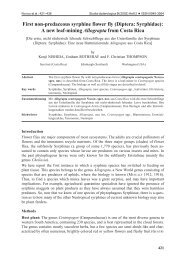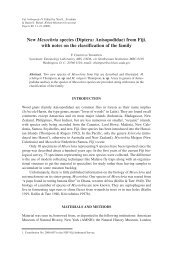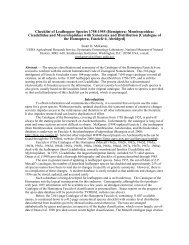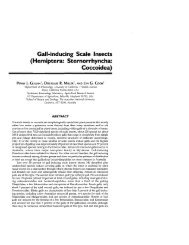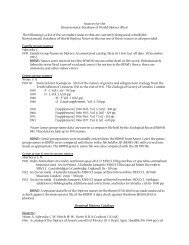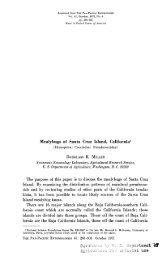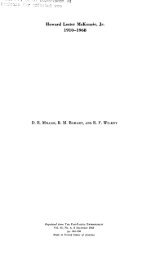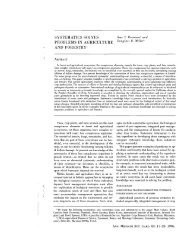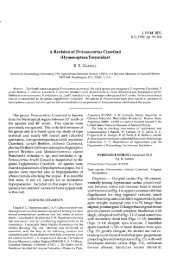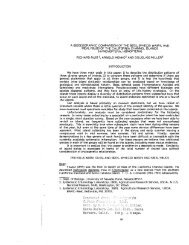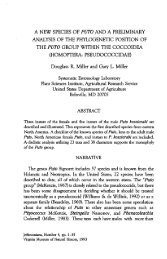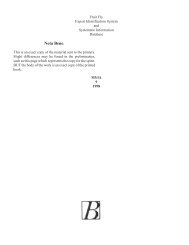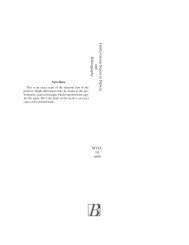Systematic revision of the Family Micrococcidae (Homoptera ...
Systematic revision of the Family Micrococcidae (Homoptera ...
Systematic revision of the Family Micrococcidae (Homoptera ...
You also want an ePaper? Increase the reach of your titles
YUMPU automatically turns print PDFs into web optimized ePapers that Google loves.
- 240<br />
RESULTS AND DISCUSSION<br />
Two equally parsimonious trees were found (length=88, CI=53, RI=73).<br />
The difference in <strong>the</strong> two trees stemmed around <strong>the</strong> position <strong>of</strong> Coccus hesperidum<br />
relative to <strong>the</strong> o<strong>the</strong>r two s<strong>of</strong>t scale species, i.e., ei<strong>the</strong>r C. hesperidum is<br />
<strong>the</strong> sister <strong>of</strong> <strong>the</strong> group comprising Pulvinaria acericola and Sphaerolecanium<br />
prunastri or all three species form a trichotomy. We have chosen <strong>the</strong> former<br />
(Fig. XVI) since it is <strong>the</strong> tree that is produced using successive weighting and is<br />
<strong>the</strong> only tree produced when using <strong>the</strong> mh* function in combination with<br />
branch swapping. Differences in <strong>the</strong> two trees do not effect <strong>the</strong> conclusions <strong>of</strong><br />
this paper.<br />
CHARACTERS THAT JUSTIFY THE MONOPHYLY OF THE CLADES ARE<br />
AS FOLLOWS.<br />
Stem 1. Adult female with microtubular ducts (4.b); trilocular pores absent<br />
(6.1); quinquelocular pores present (7.1). First instar with ostioles absent<br />
(12.1); tibiae with four or five setae (I5.1); tarsal digitules clubbed (17.1);<br />
antennae 6-segmented (19.1); trochanter sensoria transverse or nearest coxa<br />
(21.1); with eight or fewer setae on labium (23.1); with 2 or fewer lines <strong>of</strong> setae<br />
on each side <strong>of</strong> dorsum (24.1). Adult male with ungual digitules clubbed (28.1);<br />
TABLE 1. - The character matrix used in <strong>the</strong> phylogentic analysis. A «-» is given when a character<br />
state is unknown.<br />
Character Number<br />
00000000011l 1111l1l12222222 22233333 3 333<br />
123456789011 234567890123456 78901234 5 678<br />
a<br />
kosztarabi 000000000000 000000000000000 00000000 o 000<br />
bodenheimeri 01l101l0001l 110211121112210 ll-I--I o OIl<br />
sallei 001201100000 111301010112201 01000100 1 100<br />
droserae 000211100000 101l01010101l00 01000100 1 no<br />
viridis 00120110000 100101010112100 01000100 1 100<br />
conica 000-01l00000 1012011IOIOllOO 01000100 1 100<br />
fagisuga 000201100010 111301020101101 ------- 1 100<br />
arundinariae 001l01l00010 110211111112210 11211001 o 101<br />
larreae 001l01l0001 111301111112210 01200100 1 000<br />
adentocorymbus IlllOllOOIOO 111301011113200 01201001 1 000<br />
proteae IllllllOOIOO 111301011113200 01201101 1 000<br />
acaciae IlllllllllOO 101301010112210 01201100 1 010<br />
andinus 101l1l1l0100 111301011101200 01201100 1 010<br />
pollini 101-1l100000 111301011111200 01201100 1 000<br />
gilletti 001101100000 101101010101200 01200100 1 110<br />
pubescens 00110110000 101l01011l01200 01200100 no<br />
hesperidum 01l101l01l00 110311111112210 01200011 o 000<br />
acericola 011101101100 110211111112210 01200011 o 000<br />
prunastri 01l-01l01l00 110211111112210 01200011 o 000<br />
fibrillae 011101100011 110211111112210 ------- o OIl



